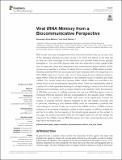Por favor, use este identificador para citar o enlazar a este item:
http://hdl.handle.net/10261/166714COMPARTIR / EXPORTAR:
 SHARE SHARE
 CORE
BASE CORE
BASE
|
|
| Visualizar otros formatos: MARC | Dublin Core | RDF | ORE | MODS | METS | DIDL | DATACITE | |

| Campo DC | Valor | Lengua/Idioma |
|---|---|---|
| dc.contributor.author | Ariza-Mateos, Ascensión | - |
| dc.contributor.author | Gómez-Castilla, Jordi | - |
| dc.date.accessioned | 2018-06-20T10:53:04Z | - |
| dc.date.available | 2018-06-20T10:53:04Z | - |
| dc.date.issued | 2017-12-05 | - |
| dc.identifier | doi: 10.3389/fmicb.2017.02395 | - |
| dc.identifier | issn: 1664-302X | - |
| dc.identifier.citation | Frontiers in Microbiology 8 (2017) | - |
| dc.identifier.uri | http://hdl.handle.net/10261/166714 | - |
| dc.description.abstract | RNA viruses have very small genomes which limits the functions they can encode. One of the strategies employed by these viruses is to mimic key factors of the host cell so they can take advantage of the interactions and activities these factors typically participate in. The viral RNA genome itself was first observed to mimic cellular tRNA over 40 years ago. Since then researchers have confirmed that distinct families of RNA viruses are accessible to a battery of cellular factors involved in tRNA-related activities. Recently, potential tRNA-like structures have been detected within the sequences of a 100 mRNAs taken from human cells, one of these being the host defense interferon-alpha mRNA; these are then additional to the examples found in bacterial and yeast mRNAs. The mimetic relationship between tRNA, cellular mRNA, and viral RNA is the central focus of two considerations described below. These are subsequently used as a preface for a final hypothesis drawing on concepts relating to mimicry from the social sciences and humanities, such as power relations and creativity. Firstly, the presence of tRNA-like structures in mRNAs indicates that the viral tRNA-like signal could be mimicking tRNA-like elements that are contextualized by the specific carrier mRNAs, rather than, or in addition to, the tRNA itself, which would significantly increase the number of potential semiotic relations mediated by the viral signals. Secondly, and in particular, mimicking a host defense mRNA could be considered a potential new viral strategy for survival. Finally, we propose that mRNA's mimicry of tRNA could be indicative of an ancestral intracellular conflict in which species of mRNAs invaded the cell, but from within. As the meaning of the mimetic signal depends on the context, in this case, the conflict that arises when the viral signal enters the cell can change the meaning of the mRNAs' internal tRNA-like signals, from their current significance to that they had in the distant past. | - |
| dc.description.sponsorship | Spanish National Ministry of Economics and Competiveness (MINECO), grant SAF-52400-R; Instituto de Salud Carlos III, CIBERehd (Centro de Investigación en Red de Enfermedades Hepáticas y Digestivas). | - |
| dc.relation.isversionof | Publisher's version | - |
| dc.rights | openAccess | - |
| dc.subject | HCV | - |
| dc.subject | RNase P | - |
| dc.subject | Codes | - |
| dc.subject | cetRNA | - |
| dc.subject | tRNA-mimics | - |
| dc.subject | ceRNA | - |
| dc.subject | Biosemiotics | - |
| dc.subject | Biocommunications | - |
| dc.title | Viral tRNA mimicry from a biocommunicative perspective | - |
| dc.type | artículo | - |
| dc.identifier.doi | 10.3389/fmicb.2017.02395 | - |
| dc.relation.publisherversion | https://doi.org/10.3389/fmicb.2017.02395 | - |
| dc.date.updated | 2018-06-20T10:53:04Z | - |
| dc.description.version | Peer Reviewed | - |
| dc.language.rfc3066 | eng | - |
| dc.rights.license | https://creativecommons.org/licenses/by/4.0/ | - |
| dc.contributor.funder | Centro de Investigación Biomédica en Red Enfermedades Hepáticas y Digestivas (España) | - |
| dc.contributor.funder | Ministerio de Economía y Competitividad (España) | - |
| dc.contributor.funder | Instituto de Salud Carlos III | - |
| dc.relation.csic | Sí | - |
| dc.identifier.funder | http://dx.doi.org/10.13039/501100004587 | es_ES |
| dc.identifier.funder | http://dx.doi.org/10.13039/501100003329 | es_ES |
| dc.identifier.pmid | 29259593 | - |
| dc.type.coar | http://purl.org/coar/resource_type/c_6501 | es_ES |
| item.openairetype | artículo | - |
| item.grantfulltext | open | - |
| item.cerifentitytype | Publications | - |
| item.openairecristype | http://purl.org/coar/resource_type/c_18cf | - |
| item.fulltext | With Fulltext | - |
| Aparece en las colecciones: | (CBM) Artículos (IPBLN) Artículos | |
Ficheros en este ítem:
| Fichero | Descripción | Tamaño | Formato | |
|---|---|---|---|---|
| GómezJ_ViralRNAMimicry.pdf | 610,59 kB | Adobe PDF |  Visualizar/Abrir |
CORE Recommender
PubMed Central
Citations
7
checked on 21-mar-2024
SCOPUSTM
Citations
16
checked on 16-abr-2024
WEB OF SCIENCETM
Citations
14
checked on 25-feb-2024
Page view(s)
319
checked on 19-abr-2024
Download(s)
235
checked on 19-abr-2024

